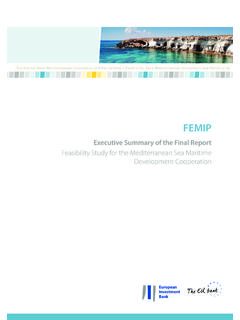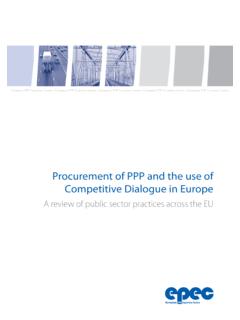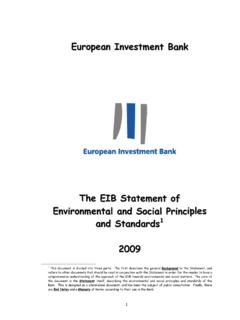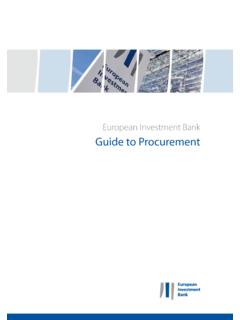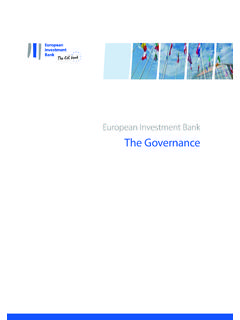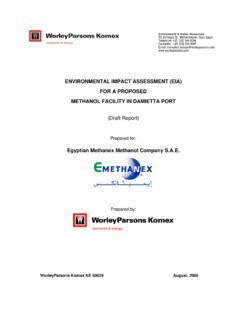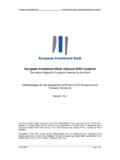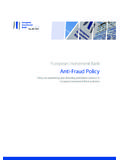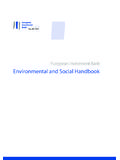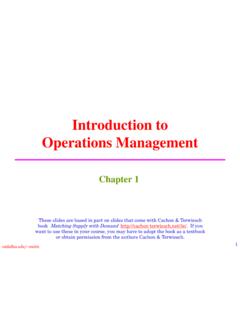Transcription of The Economic Appraisal of Investment Projects at the EIB
1 The Economic Appraisal of Investment Projects at the EIBV ersion March 2013 Under reviewThe Economic Appraisal of Investment Projects at the EIB Version March 2013 Under reviewEuropean Investment Bank The Economic Appraisal of Investment Projects at the EIB 30 October 2020 page 1 / 211 The Economic Appraisal of Investment Projects at the EIB Projects Directorate March 2013 (Under review) 30/10/2020 Note to the Reader The EIB Projects Directorate conducts technical and Economic Appraisal of the Projects financed by the Bank, and JASPERS includes Economic Appraisal in its project preparation assistance. Economic Appraisal plays a central role in the operations of the EIB. It allows the Bank to judge whether an Investment project will contribute to the Economic growth and cohesion of the EU and the Economic progress of its partners.
2 This guide, which was published in April 2013 in the EIB website, illustrates how the Bank conducts Economic Appraisal across the sectors of the economy where it operates. The transformation of the EIB into the EU Climate Bank, as well as research advances in some of the elements of the Appraisal require that the guide be revised. Amongst some of the elements requiring revision there are: the cost of carbon, the value of time (VoT) in transport and the value of transport safety. This version under review provides links to updated documents for their use until the new version of the guide is available by end of 2021 at the latest. European Investment Bank The Economic Appraisal of Investment Projects at the EIB 30 October 2020 page 2 / 211 Table of Contents List of Abbreviations and Acronyms .. 3 Contributors .. 6 Foreword 8 1 Introduction.
3 9 PART 1: METHODOLOGY TOPICS: CROSS-SECTOR .. 14 2 Financial and Economic Appraisal .. 15 3 Defining the Counterfactual Scenario .. 20 4 Incorporating Environmental Externalities .. 24 5 Land Acquisition and Resettlement .. 28 6 Wider Economic Impacts .. 31 7 Economic Life and Residual Value .. 41 8 The Social Discount Rate .. 44 9 Multi-Criteria Analysis (MCA) .. 53 10 Risk Analysis and Uncertainty .. 66 PART 2: METHODOLOGY TOPICS: 72 11 Security of Energy Supply .. 73 12 The Value of Time in Transport .. 79 13 The Value of Transport Safety .. 81 14 Road Vehicle Operating Costs .. 82 15 Traffic Categories in Transport .. 84 16 Risk-Reduction Analysis in Water .. 92 PART 3: SECTOR METHODS AND CASES .. 97 17 Education and Research .. 98 18 Renewable Energy .. 106 19 Electricity Network Infrastructure .. 110 20 Energy Efficiency and District Heating .. 115 21 Health.
4 118 22 Private Sector Research, Development and Innovation (RDI) .. 125 23 Software RDI .. 132 24 Research Infrastructure .. 137 25 Manufacturing Capacity .. 142 26 Telecommunications .. 146 27 Biofuel Production .. 156 28 Tourism .. 160 29 Interurban Railways .. 165 30 Roads .. 171 31 Urban Public 178 32 Airports .. 182 33 Seaports .. 186 34 Regional and Urban Development .. 189 35 Public Buildings .. 196 36 Solid Waste Management .. 201 37 Water and Wastewater .. 205 European Investment Bank The Economic Appraisal of Investment Projects at the EIB 30 October 2020 page 3 / 211 List of Abbreviations and Acronyms 3G: Third generation (of mobile telecommunications technology) ACP: Africa, Caribbean and Pacific Mandate of the EIB AIC: Average incremental cost B/C: Benefit-cost (ratio) BGC: Behavioural generalised cost BREEAM: Building Research Establishment Environmental Assessment Method CAPM: Capital asset pricing model CBA: Cost-benefit analysis CCGT: Combined cycle gas turbine CEA: Cost-effectiveness analysis CF: Conversion factor DDGS: Dried distiller grains and solubles DH: District heating DSL: Digital subscriber line EC: European Commission EE: Energy efficiency EIA: Environmental impact assessment EIB: European Investment Bank, or the Bank EIRR.
5 Economic internal rate of return (also referred to as ERR) ENPV: Economic net present value EPO: European Patent Office ERDF: European Regional Development Fund ERIAM: Economic Road Infrastructure Appraisal Model ERP: Enterprise resource planning ERR: Economic rate of return (also referred to as EIRR) ETS: (EU) Emissions Trading Scheme EU: European Union FDI: Foreign direct Investment FEMIP: Facility for Euro-Mediterranean Investment and Partnership FIRR: Financial internal rate of return (also referred to as FRR) FNPV: Financial net present value FP: (EU Research) Framework Programme FRR: Financial rate of return (also referred to as FIRR) FTTH: Fibre to the home FTTx: Fibre to the (home/building/curb) GC: Generalised cost GHG: Greenhouse gas GJ: Giga Joule GMO: Genetically modified foods GDP: Gross domestic product GSM: Global System for Mobile Communications HEV: Hybrid electric vehicle HGV: Heavy goods vehicle HR: Human resources HSPA+: Evolved high-speed package access HV: Heavy vehicle (transport context) or high voltage (energy context) IATA: International Air Transport Association ICE: Internal combustion engine ICT: Information and communications technologies IFI: International financial institution ILUC: Indirect land-use change IM: Infrastructure manager IO: Input-output IP: Intellectual property IPPC: Integrated Pollution Prevention and Control IRR: Internal rate of return IT: Information technology European Investment Bank The Economic Appraisal of Investment Projects at the EIB 30 October 2020 page 4 / 211 JASPERS: Joint Assistance to Support Projects in European Regions kV: kilo Volt KW h: Kilowatt-hour LC: Levelised cost LCU.
6 Local currency units LCOE: Levelised cost of energy LNG: Liquefied natural gas LTE: Long-term evolution LV: Light vehicle (transport context) or low voltage (energy context) MBT: Mechanical biological treatment MCA: Multi-criteria analysis MLD: Mega litre MV: Medium voltage MVA: Megavolt-ampere MW: Megawatt MWh: Megawatt-hour NPC: Net present cost NPV: Net present value OCF: Operating cash-flow OECD: Organisation for Economic Co-operation and Development O&M: Operations and maintenance OPEX: Operating expenditure OPS: Operations Department of the EIB PC: Personal computer PHEV: Plugged-in hybrid electric vehicle PJ: Projects Department of the EIB PPP: Public-private partnership PSO: Public service obligation PV: Present value R&D: Research and development RDI: Research, development and innovation RI: Research infrastructure RM: Risk Management Department of the EIB ROA: Real option analysis ROIC: Return on invested capital RU: Railway undertaking SAAS: Software as a service SME: Small and medium-sized enterprises SP: Stated preference SPL: Structural programme loan SRAS: Single radio access network STPR: Social time preference rate STS: Ship to shore SW: Solid waste SW M: Solid waste management TAC: Track access charge TEU: Twenty feet equivalent (container) unit TSO: Transmission system operator TTM: Time to market TWh: Terawatt-hour UGS: Underground gas storage UMTS: Universal mobile telecommunications system UNWTO: United Nations World Tourism Organisation (UNWTO) VAT: Value-added tax VHV: Very high voltage VOC: Vehicle operating costs VOT: Value of time VPD: Vehicles per day WACC: Weighted average cost of capital W&S.
7 Water and sanitation European Investment Bank The Economic Appraisal of Investment Projects at the EIB 30 October 2020 page 5 / 211 WHO: World Health Organisation WOP: Without project WP: With project WTO: World Trade Organisation WTE: Waste to energy WTP: Willingness to pay WWTP: Wastewater treatment plant European Investment Bank The Economic Appraisal of Investment Projects at the EIB 30 October 2020 page 6 / 211 Contributors This guide was prepared by EIB staff members involved in project Appraisal and Economic analysis, as detailed below. The authors benefited from the advice of a panel of external academic advisors, comprising Prof. Martin Buxton (University of Brunel), Prof. Gin s de Rus (Universities of Las Palmas and Carlos III), Prof. Georg Erdmann (Technical University of Berlin), Prof. Per-Olov Johansson (Stockholm School of Economics), and Prof.
8 Reinhilde Veugelers (University of Louvain). The role of the panel was purely advisory, and no errors or omissions should be attributed to its members. The authors of the document were the following: Coordinator and introductory chapter: J. Doramas Jorge-Calder n Part 1: Methodology topics cross-sector Financial and Economic Appraisal : Harald Gruber and Pierre-Etienne Bouchaud Defining the counterfactual scenario: J. Doramas Jorge-Calder n Environmental externalities: Edward Calthrop Land take and resettlement: Edward Calthrop Wider Economic impacts: Edward Calthrop Economic life and residual value: Diego Ferrer The social discount rate: Armin D. Riess Multi-criteria analysis: Christine Blades Risk analysis and uncertainty: J. Doramas Jorge-Calder n Part 2: Methodology topics sector-specific Security of energy supply: Nicola Pochettino Value of time in transport: Diego Ferrer and Claus Eberhard Value of transport safety: Claus Eberhard and Diego Ferrer Road vehicle operating costs: Pierre-Etienne Bouchaud Traffic categories in transport: J.
9 Doramas Jorge-Calder n Risk reduction analysis in water: Thomas van Gilst Part 3 Sector methods and cases Education and research: Heikki Kokkala Power generation: Jochen Hierl Renewable energy: David Kerins and Juan Alario Electricity network infrastructure: Jochen Hierl Gas grids, terminals and storage: Nicola Pochettino Energy Efficiency and district heating: David Kerins and Juan Alario Health: Christine Blades Private sector RDI: Antonello Locci and Tom Andersen Software RDI: Anders Bohlin Research infrastructure: Jacques Van Der Meer Manufacturing capacity: Tom Andersen Telecommunications: Jussi H t nen Biofuel production: Oliver Henniges Tourism: Campbell Thomson Interurban railways: Alfredo D az European Investment Bank The Economic Appraisal of Investment Projects at the EIB 30 October 2020 page 7 / 211 Roads: Pierre-Etienne Bouchaud Urban public transport: Mauro Ravasio Airports: J.
10 Doramas Jorge-Calder n Seaports: J. Manuel Fern ndez Riveiro Regional and urban development: Sebastian Hyzyk and Brian Field Public buildings: Lourdes Llorens, Mariana Ruiz and Brian Field Solid waste management: Patrick Dorvil Water and wastewater: Thomas van Gilst and Monica Scatasta The authors are grateful to colleagues who reviewed earlier drafts of the guide, including Ann-Louise Aktiv Vimont, Edward Calthrop, Harald Gruber, Armin D. Riess and Timo V lil . Thanks also to colleagues who assumed coordinating roles within particular sectors, including Brian Field, Harald Gruber, Jochen Hierl, and J. Doramas Jorge-Calder n, as well as to colleagues who coordinated input from JASPERS, including Antonio Almagro, Alan Lynch, Tudor Radu and Pasquale Staffini. Jos Lu s Alfaro kindly commented on parts of the guide. Finally, the authors thank St phanie Marion for assistance during the preparation and formatting of the document and Mirjam Larsson for assistance with the preparation of tables.
